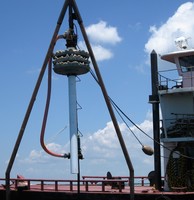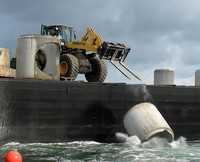GULF SHORES – It was a LuLu of a good time on May 26, 2013 when hundreds of boats gathered to watch Walter Marine send a retired 271-foot freighter to the bottom of the Gulf some 18 miles off of …
This item is available in full to subscribers.
Please log in to continue |







GULF SHORES – It was a LuLu of a good time on May 26, 2013 when hundreds of boats gathered to watch Walter Marine send a retired 271-foot freighter to the bottom of the Gulf some 18 miles off of Orange Beach.
Thanks to BP money in the form of a grant from the National Fish and Wildlife Foundation, the state of Alabama wants to do that three more times, says Director of the Marine Resources Division of the Alabama Department of Conservation and Natural Resources, Chris Blankenship.
“It’s $11.5 million over three years,” Blankenship said. “As part of this project we’re going to deploy three large ships as reefs. We have those budgeted in 2017 and 2018. We’d like to have something the size of the LuLu, 250-feet to 300-feet if we can find something like that.”
Walter Marine is already hunting for those ships, according to David Walter.
The three ships will part of an extensive and expanding reef program off the coast of Alabama.
“We’re going through the permitting process with the Corps of Engineers and we hope to get that later this year and start deployment next year,” Blankenship said. “We’re going to build 600 reefs in that nine-mile reef zone we’re going to create. We got a lot of stuff going on.”
All of this is just added to what Blankenship says is the largest artificial reef program in the United States.
“We have over a thousand square miles of reef area offshore and in that reef area and there are about 15,000 reefs,” he said. “We’re still continuing to add reefs within those reef zones.”.
And while the adding of big ships and reefs causes excitement there is another part the grant will fund to study the impact reefs have on the Gulf fishery.
“We’re doing some research on what’s there before, what’s there after we place the reef for a couple of years to see how that complex grows,” Blankenship said. “We’re doing this on the super reefs and some of the small pyramid reefs and some other juvenile habitat material we plan to place out next year.
“They’re really getting a good research component of this so we can have a broad picture of the success of our reefing program.”
Blankenship said eventually the public will have access to all of the coordinates of all of the reefs, some will be held back during the research part of the project.
It’s really a top to bottom program, he said, starting with the ships, 25-foot super reefs, eight-foot reefs and the smaller round eco-reefs that are used as snorkeling reefs as well as habitat in deeper water.
“As part of our continuing reef building program, we experimented with these 25-foot-tall super reefs,” Blankenship said. “We sunk several a couple of years ago to see how they would do.
“Our hope was we could sink two or three of these in a location and space them about 75 yards apart and they would mimic a large vessel or a small ship and would do real well for vermillion snapper and amberjack. They’ve been very successful.”
A series of the eco-reefs will be placed closer to shore to give hatchlings a place to hide and thrive.
“We put 125 within three miles of the beach and they’ve been very effective in these areas for juvenile habitat, reef fish and also for Spanish mackerel, king mackerel and sheepshead in the winter months,” Blankenship said. “They’re close enough to shore that they are easily accessible by small vessels on nice days.”
The program will also include added inshore reefs in Mobile Bay and refurbishing existing inshore reefs managed by the state. Also recently added were three large barges of discarded concrete pipes and culverts deployed just a few miles offshore.